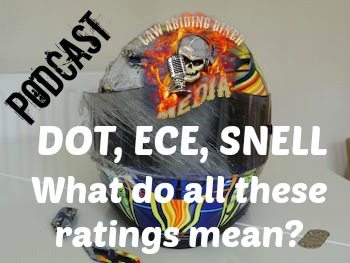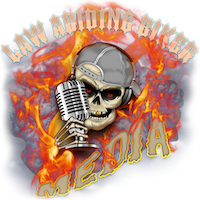Podcast: Play in new window | Download | Embed
Subscribe: Apple Podcasts | RSS
 In this episode we talk in-depth about the different motorcycle helmet ratings out there & that crazy sticker on the back of your helmet. This can be confusing and not everyone completely agrees on every aspect of motorcycle helmet ratings and testing. As usual we break through all the smoke and explain it in a way bikers can understand. No longer will you need to be confused on helmet ratings and what they mean for the average every day biker out there.
In this episode we talk in-depth about the different motorcycle helmet ratings out there & that crazy sticker on the back of your helmet. This can be confusing and not everyone completely agrees on every aspect of motorcycle helmet ratings and testing. As usual we break through all the smoke and explain it in a way bikers can understand. No longer will you need to be confused on helmet ratings and what they mean for the average every day biker out there.
We got your back on this and you need to listen in to get the complete breakdown. This episode was spurred from a post that one of our Patrons, Dar Cheng, left in our Private Patron Only Facebook Group. Become a Patron and get in on that group.
At the end of the episode we do a rountable and give our thoughts on all that surrounds mandatory helemt laws. You'll definietly want to hear this. Below are some notes and points we hit on in this podcast episode.
If you purchase a new helmet or any motorcycle gear, please consider doing so through one of our affiliate links below. No additional cost to you.
Revzilla | Amazon | Motorcycle Superstore | Rocky Mountan ATV & MC
Related Links:
Three Most Popular & Respected Motorcycle Helmet Ratings:
- DOT
- Known as DOT (Dept of Transportation)
- Federal Motor Vehicle Safety Standard
- First issued in 1974 & has been updated
- All U.S. helmets must meet this to be used on public highways in States that have laws
- DOT is “random” testing after the helmet is released to the market
- Trust based:
- manufactuers test themselves to make sure helemets meet standards
- SNELL
- SNELL Memorial Foundation
- Private non-profit
- Issues its own motorcycle helmet standard
- Voluntarily:
- Manufacuters have to apply for and be approved
- Many of the same tests and standards as the DOT
- However, harder testing to receive a SNELL standard
- SNELL will not test or certify modular motorcycle helmets
- ECE
- Economic Commission of Europe
- Mandatory standard in Europe (like DOT in United States)
- Comes from the United Nations Economic Commission for Europe
- Most common standard around the world
- Manufacturers in the U.S. wishing an ECE rating must submit an application
- ECE requires mandatory “batch testing” of helmets before they leave the factory
If helmets is deemed certified per any of the above standards, information is then placed inside the helmet somewhere, indicating manufacturer information and date, model name, size etc. And a sticker is placed on the outside rear of the helmet indicating its certification.
These four tests seem to be standard for each rating. (tests are harder for certain ratings such as SNELL & there are )
- Impact Attenuation
- Attenuation defined:
- Attenuation defined:
- a decrease in a property, as energy, per unit area of a wave or a beam of particles, occurring as the distance from the source increases as a result of absorption, scattering, spreading in three dimensions, etc.
- Helmet is dropped onto a round anvil
- Anvil defined:
- a heavy iron block with a smooth face, frequently of steel, on which metals, usually heated until soft, are hammered into desired shapes.
- And dropped onto a flat hard surface
- Attenuation defined:
- Penetration Test
- Object dropped onto a stationary helmet
- Retention System Test
- Tests chin strap and D-rings to maintain their position under tension
- Attenuation defined:
- DISAGREEMENTS BETWEEN STANDARDS
- EPS=Expanded PolyStyrene (styrofoam in helmets)
- EPS: EPS Expanded PolyStyrene is one of the most widespread foams used in our society. It is the white picnic cooler foam that you see eggs and stereo gear packed in. It is the peanuts in your mail order package. It is the white food carton or drink cup you get at a carry-out. It is cheap to manufacture, light, and has almost ideal crush characteristics with no bounce-back to make the impact more severe. It can be reliably manufactured with reasonable quality control procedures.
- SNELL (theory) believes that the thicker the EPS the more the protection
- However, the thicker EPS liner makes the helmet heavier
- ECE (theory) believes less EPS makes the helmet lighter
- Thus, less intertia during an impact
- reducing head, neck, clavicle, and back injuries
- EPS=Expanded PolyStyrene (styrofoam in helmets)
New Patrons:
- Castor Rodriguez
- Troy Gilleylen of Battle Creek, Michigan
- Paul Fullerton of Arvada, CO
If you appreciate the content we put out and want to make sure it keeps on coming your way then become a Patron too! There are benefits and there is no risk.
Join the Free Email Club!
If you appreciate this free information make sure to join the thousands of law abiding bikers that have already joined the free Email Club! You will be notified of new useful motorcycle content and techniques as we put them out. Join the Community now!



Awesome Episode Guys, very informative. Everyone that rides a bike or thinks to ride a bike should be listening to this Podcast, covers a lot of stuff on Helmets and sometimes even people riding for years don’t realise they don’t know some of the stuff and it gives a great perspective. Awesome work guys!